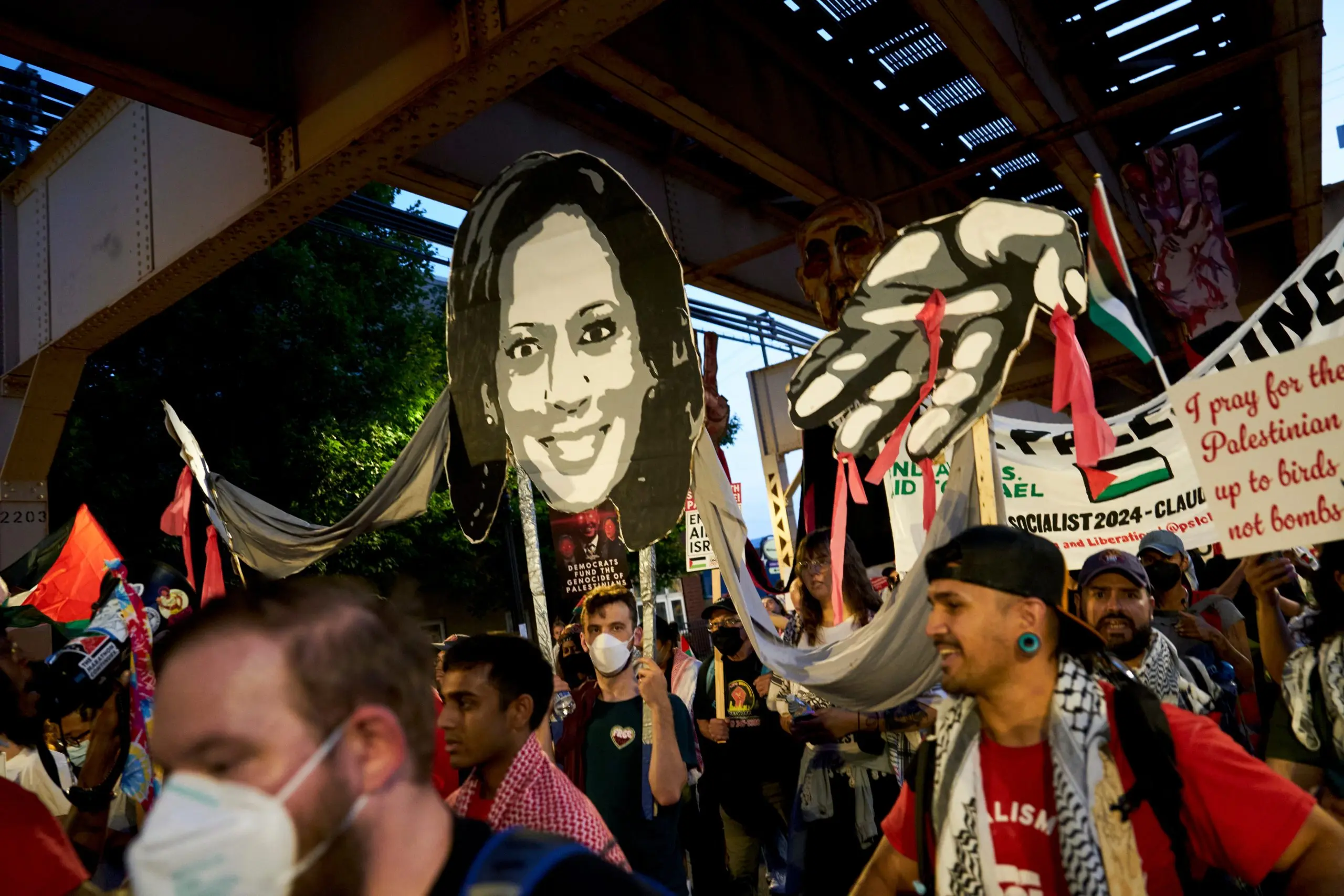Harris, with Biden’s support, began focusing less on perilous political tasks like tackling the cause of immigration and seized instead on issues such as abortion and racism, which played to her rhetorical strengths.
Those steps began yielding public appearances that seemed far more confident and assured, whether it was an address on reproductive rights or a speech in Jacksonville decrying the stance of Florida Governor Ron DeSantis, a Republican, on black history.
Loading
And some Democrats cite another reason for the vice president’s markedly relaxed demeanour since her nomination. In 2020, they say, she was trying to make a splash in a party veering sharply to the left – and was visibly uncomfortable doing it. This year, Harris’ centrism on issues like criminal justice fits much better with where most Democrats are. And she did not have to fight her way through primaries or debates, letting her bask in the adulation of crowds rather than needing to prove herself.
Nearly a dozen current and former White House officials, vice-presidential aides, and confidants detailed an effort by Harris, her supporters and the administration to reshape an image of Harris that was battered in her harrowing first year. Some of the officials and supporters spoke on the condition of anonymity to detail the sprawling internal effort.
In January 2021, Harris became the first black and Asian American woman to occupy a nationally elected office, but there was little time to celebrate. Biden and Harris were facing a pandemic, economic problems and a country riven by racial protest.
Harris’ supporters say she was eager to advance the administration’s aims, but folding into Biden’s political universe was not always easy. Biden was surrounded by people who had worked for him through countless crises. Harris’ own team was largely disassembled – and she started with many staffers who were loyal to Biden, the Democratic Party and the greater cause, but largely new to her.
US President Joe Biden and vice president Kamala Harris at the DNC winter meeting last year. This time, Biden, having given up his re-election campaign, was on leave and didn’t attend. Credit: AP
Some of Biden’s supporters questioned whether Harris was more invested in advancing his goals or her own career. During the first Democratic debate of 2019, Harris criticised Biden for having been friendly with segregationist senators, and the bitterness of that moment lingered.
“I believe there was unease around asset versus ambition,” said Bakari Sellers, a former longtime South Carolina state legislator and a longtime Harris supporter.
Early on, Biden tasked Harris with taking on the root causes of migration from Guatemala, El Salvador and Honduras, an assignment that tied her to one of the most searing issues in American politics. In an interview with NBC’s Lester Holt, Harris appeared frustrated by repeated questions about why she had not yet visited the US-Mexico border, which she did not see as part of her mandate.
“And I haven’t been to Europe,” Harris’ snapped. “And I mean, I don’t understand the point that you’re making.”
As her path grew rocky, staffers began leaving. Ashley Etienne, her communications director, left in November 2021. Symone Sanders, her chief spokesperson, departed two weeks later. Chief of staff Tina Flournoy was gone by April 2022.
Harris’ supporters say her turnaround began around that time, as Biden’s circle recognised that they had done little to help her navigate a difficult landscape with few resources. At one point, the president told senior staff that he would fire anyone discovered leaking negative stories about Harris to the media, said several aides who spoke on the condition of anonymity to describe private conversations.
Many in the White House saw the Holt interview as a flashing red light.
“What it exposed almost immediately, which was her greatest vulnerability, is that she had no infrastructure,” Etienne said. “There’s nobody I can call to help defend her, to help change the narrative. I’ve got to do something to change what is on the television. Who am I going to call?”
Etienne’s team started to catalogue what Harris did on a weekly basis and send notes to people they saw as allies who could defend the vice president in their in-groups or on TV networks.
Harris made an effort to meet more of those allies in person, especially after pandemic restrictions eased. Her office launched a number of tours, including one that took her to college campuses across the country. She convened meetings with reproductive rights advocates in her office.
Harris’ associates say that as she spoke to people who supported her, focusing on issues she strongly believed in, she began to find her footing.
Former White House chief of staff Ron Klain said Harris was also working hard behind the scenes – for example, preparing assiduously for the daily national security briefings delivered to her and Biden.
“Of all the participants, she came the best prepared, ready with questions, having already reviewed the written intelligence and ready to help ask hard questions … and helped shape the president’s ability to digest and process that intelligence,” Klain said.
Loading
But the most dramatic turning point came in May 2022, after word leaked that the Supreme Court was poised to overturn the constitutional right to an abortion. Democrats saw it as a galvanising issue, but Biden had long shown discomfort when it came to a full-throated embrace of abortion rights, given his Catholic faith.
That created an opening and a moment for Harris.
“It was that summer of 2022 where everything was on the line,” said Donna Brazile, a Harris confidant and the former head of the Democratic National Committee. “It was not just on the line for the administration. I think it really was also on the line for her.”
Klain asked Harris to spearhead the administration’s response, and she travelled the country warning that not just abortion rights but also an array of other freedoms were under threat from Republicans and conservatives.
Reflecting the Biden circle’s growing confidence in Harris, she had a green light to quickly go to places that made the most sense, even with just a few hours’ notice. “In the White House, you can always come up with a lot of good reasons why people shouldn’t be spontaneous,” Dunn said. “And she was at the point where she was like, ‘This is what I want to do.’ And certainly, I think many of us were supportive of it.”
In event after event, Harris sharpened her arguments and developed resonant ways of talking about an issue central to Democrats’ electoral prospects.
“The right of every woman in every state in this country to make decisions about her own body is on the line,” the vice president said during a speech in Tallahassee on the anniversary of the Roe v Wade decision. “And I’ve said it before, and I will say it again: How dare they? How dare they? … Can we truly be free if a woman cannot make decisions about her own body?”
She sought to replicate that nimbleness in other areas.
Loading
She travelled to Florida to take on DeSantis’ “war on woke” and changes to public school curriculum that said black people benefited from slavery. And she made a surprise visit to meet three Democratic legislators in Tennessee who were kicked out of their posts by their Republican colleagues after protesting against gun laws in the statehouse.
“That is not a democracy,” Harris said of the move to expel the legislators. “You can’t walk around with your lapel pin and you’re not representing the values that we hold here as Americans.”
It was during those moments that she began to workshop some of the themes that have since appeared in her stump speeches, taking Republicans to task for ostensibly wanting to ban books, rewrite history, even end in vitro fertilisation.
Supporters say they began to see a more assured version of Harris, one that has commanded the stage in the month since she became the likely Democratic nominee.
“People who have only started seeing her again … may have been a little surprised by the intensity of crowd reaction to her, by her confidence and her ability to connect,” Dunn said. “But anyone who has been watching her over the last couple of years is not going to be surprised.”
The Washington Post





















Discussion about this post